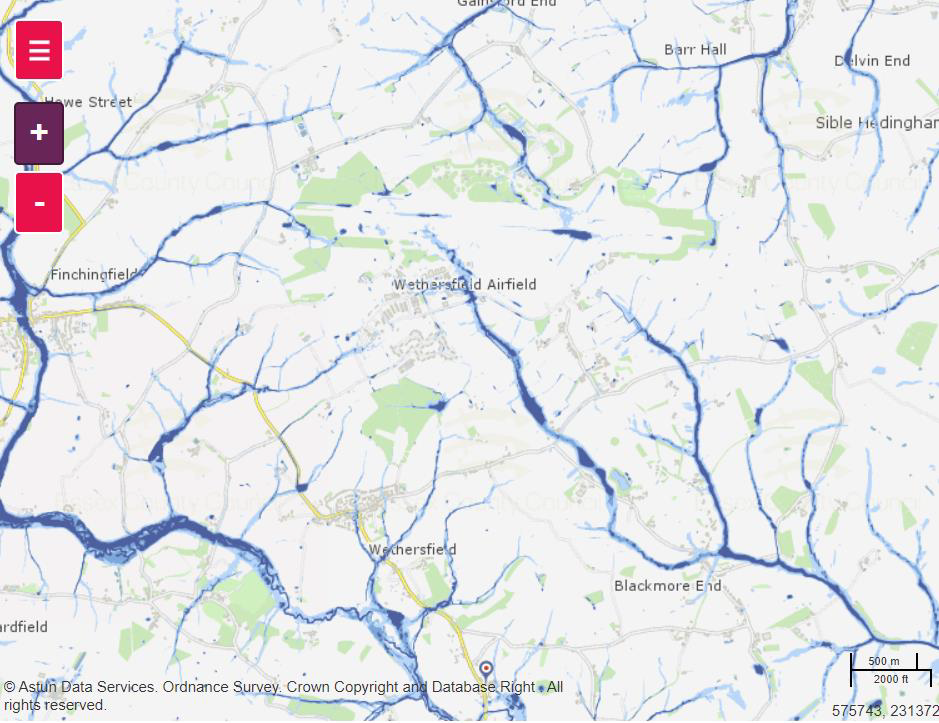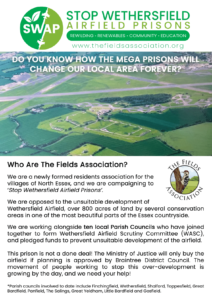Finchingfield Parish Council
Prison Application Update
Wethersfield Prison consultation response
Introduction
Better Braintree – Together exists to unite residents of the district who are interested in planning and environmental matters. We wish to see greater involvement in decision-making for local communities and greater protections for the environment, with sustainable transport prioritized.
The proposals for two prisons at Wethersfield airfield, comprise:
• Two prison blocks of capacity 1,715 each;
• 7 separate house blocks per prison, each 4 storeys;
• Support buildings, including a reception area, kitchens, workshops, a visits hall and offices;
• 500 parking spaces per prison.
Concerns
We set out below are concerns about the proposals and about this consultation, focusing on:
1. Inadequate consultation
2. Environmental impact of the proposal
3. Better alternatives: “Wild Wethersfield”
1. Inadequate consultation
Case law is clear that there are certain minimum standards for consultations. These are known as the Gunning Principles, following the Moseley vs Haringey case. This consultation breaches principle 2, ““there is sufficient information to give ‘intelligent consideration’ The information provided must relate to the consultation and must be available, accessible, and easily interpretable for consultees to provide an informed response’.
It is simply not possible, from the very limited information1 available, to submit a considered response to this consultation.
We do not believe that this consultation is acceptable for submission as part of a Statement of Community Involvement in any planning application to be submitted, because:
• There is no traffic information, no environmental information, no detailed CO2 information, no water or sewage treatment requirements etc. Data from other prisons across the estate should have been made available for comparison and analysis.
• Given the scale of the proposals (big enough to require an Environmental Impact Assessment), villages in Great Bardfield, Toppesfield & the Salings should have been notified and were not.
• Wethersfield Parish Council was not consulted
• The entirely online nature of the consultation also raises concerns about accessibility and diversity.
• Residents are also concerned about unanswered questions with regards to the future use of the remainder of the site.
2. Environmental impact of the proposal
It is likely that the construction of two prisons in this peaceful and rural area will have a severe impact, not just on the site itself, but throughout the local area, as well as on the surrounding wildlife and its habitats. Impacts are likely to include:
• Unacceptable risk to protected species, both directly, through loss of habitat, and indirectly, through disruption by the noise, air and light pollution associated with the prison. Professional surveys into the wildlife, birds, insects, vegetation etc. have been lodged with Braintree District Council Planning & Environment Dept by Ros Gourgey (previously Sustainability Manager of the site). To date, 74 species of birds have been identified on site, including migrants, many on International ‘Red & Amber endangered and protected lists’. We would remind you of the importance of following the Mitigation Hierarchy (see Appendix 1). If there are protected species on site then harm must be avoided. A ‘Biodiversity Net Gain’ offsetting approach is not acceptable in these circumstances
• Traffic (construction, prison staff, visitors, in-mate movements) on unsuitable, rural roads. The need for 1000 parking spaces gives a startling idea of the likely amount of visitor and staff traffic. Associated noise, light and air pollution from traffic
• High CO2 emissions during the construction phase3
• Site light pollution & noise
• Impact on land-scape character of fourteen 4-storey ‘house blocks’ and all the associated prison buildings, up to 4-storeys high
• Water:
o Water use and impact on the environment, both during construction phase (including for dust suppression) and once the prison is operational. North Essex is already a water-stressed area4, the chalk aquifer over-committed and many local rivers only kept flowing by Sewage Treatment Works discharges
o Sewage: Capacity issues in local sewage treatment system. This scheme was not included in the 2017 district water cycle study, which has already indicated pinch points in the system. A proposal of this size risks an increase in the dumping of sewage in rivers (both directly, due to sewage from the prison, and indirectly, from ground-water run-off)
o Flooding: possible increase in local flooding due to loss of site permeability. See local flood map in Appendix 2
o Quality: Possible reduced water quality in local watercourses, draining into the Colne and Blackwater catchments – risk to Water Framework Directive status
These are just some of the possible impacts. No doubt there will be more, but the inadequate information supplied for this consultation does not allow us to ascertain what those might be. In essence, it is likely that the prison proposal will bring many problems and few benefits.
3. Better alternatives, “Wild Wethersfield”
Instead of building on the site, rewild it! There is a desire for greater environmental protections for our rural areas, which have been under enormous pressure from house-building in recent years.
This is clearly demonstrated by the large numbers of local residents who are already working on numerous schemes . These include a community natural flood management scheme at Coggeshall, a green site proposal at Great Saling, the famous beaver project at Spains Hall5 and the ‘North Essex Green Corridor’ between Coggeshall and Gosfield6, which could easily be extended. There is also a re-wilding project at Grays Farm7, near the airfield, using 300 acres of land, which is likely to suffer from the environmental affects outlined above. In addition, Essex County Council’s Climate Commission has ambitious goals, with particular focus on the Blackwater catchment, just to the west of the site and into which some water from the site flows.
‘Wild Wethersfield’ would fit neatly in with these schemes. There are so many opportunities nowadays to do good for wildlife whilst still making money from land. It could involve one of the following, or a similar approach:
• The Environment Bank – This is a commercial organisation actively seeking estates of at least 10 hectares (and ideally much bigger) where the land-owner is willing to implement biodiversity enhancements. In return, the land-owner will be paid a sign-up fee, a fixed sum (per hectare, per annum) for 30 years, plus a management fee for site maintenance.
• Highways East – The Eastern branch of National Highways, they are currently proffering several funds of money, (totaling approximately £175m) to offset destruction caused by road-building. All funds must be spent by 2025.
• The Real Wild Estates Company – To quote them directly, they “provide investors with access to large UK landscapes of 1,000+ acres which are suitable for nature restoration with viable natural capital potential.” Projects like this bring opportunities for new jobs, and revenue for land owners from tourism.
To look at a wild future for Wethersfield would delight local people. It would fit with the goals of the Essex Climate Commission and with Braintree District Council’s climate change aspirations.
Benefits would include:
• A new, wild, recreational area for the district
• No increase in air pollution, noise pollution, and light pollution
• Cleaner rivers and flood prevention (with careful tree-planting & attenuation ponds),
• Protection for species on the site and increased biodiversity
• A contribution towards the achievement of Essex County Council and Braintree Council’s climate goals.
Rosie Pearson, Founder, Better Braintree – Together stopurbansprawlnow@gmail.com


